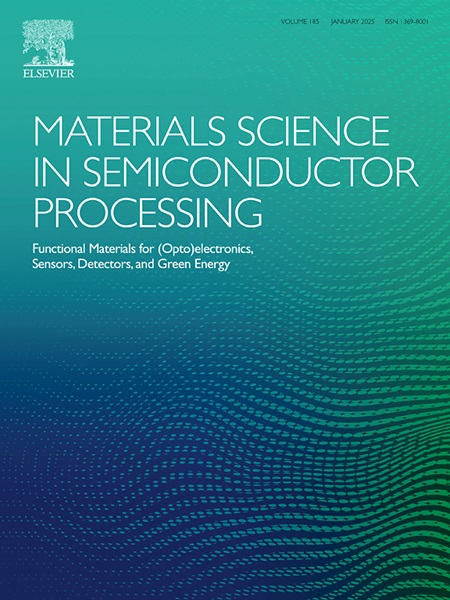Reduction of Ge MOS interface defects via Al2O3 or trimethylaluminum pre-doping combined with post-oxidation
IF 4.2
3区 工程技术
Q2 ENGINEERING, ELECTRICAL & ELECTRONIC
引用次数: 0
Abstract
The reduction of interface defects in Ge metal-oxide-semiconductor (MOS) through Al2O3 or Al(CH3)3 [trimethylaluminum (TMA)] pre-doping combined with ozone post-oxidation is investigated. The interface defects are mainly caused by Ge sub-oxides (Ge3+-O, Ge2+-O and Ge1+-O) in interfacial layer (IL). Compared to samples with only ozone oxidation, those subjected to Al2O3 pre-doping combined with ozone post-oxidation (AOZ) exhibit better interfacial properties. This improvement is attributed to the reduction in the formation of Ge sub-oxides due to the effective suppression of oxygen diffusion to the substrate by the deposition of Al2O3. Samples with TMA pre-doping combined with ozone post-oxidation (TOZ) demonstrate lower interface trap density (Dit) of only 4.6 × 1010 eV−1 cm−2, which is attributed to the reduced formation of sub-oxides and Al-O bonds. In these samples, Ge3+, Ge2+, and Ge1+ are predominantly confined within the Al-O network to form AlGeOx. Additionally, changing the number of TMA cycles reveals that the TOZ samples can achieve better passivation effects than the AOZ samples under similar or smaller EOT.
Al2O3或三甲基铝预掺杂与后氧化相结合减少Ge MOS界面缺陷
研究了Al2O3或Al(CH3)3[三甲基铝(TMA)]预掺杂与臭氧后氧化相结合减少锗金属氧化物半导体(MOS)中界面缺陷的方法。界面缺陷主要由界面层(IL)中的Ge亚氧化物(Ge3+-O、Ge2+-O和Ge1+-O)引起。与仅臭氧氧化的样品相比,经Al2O3预掺杂和臭氧后氧化(AOZ)处理的样品具有更好的界面性能。这种改善是由于Al2O3的沉积有效抑制了氧向基体的扩散,从而减少了Ge亚氧化物的形成。经TMA预掺杂和臭氧后氧化(TOZ)处理的样品显示出较低的界面阱密度(Dit),仅为4.6 × 1010 eV−1 cm−2,这是由于亚氧化物和Al-O键的形成减少。在这些样品中,Ge3+、Ge2+和Ge1+主要被限制在Al-O网络中形成AlGeOx。此外,改变TMA循环次数表明,在相同或更小的EOT条件下,TOZ样品比AOZ样品具有更好的钝化效果。
本文章由计算机程序翻译,如有差异,请以英文原文为准。
求助全文
约1分钟内获得全文
求助全文
来源期刊

Materials Science in Semiconductor Processing
工程技术-材料科学:综合
CiteScore
8.00
自引率
4.90%
发文量
780
审稿时长
42 days
期刊介绍:
Materials Science in Semiconductor Processing provides a unique forum for the discussion of novel processing, applications and theoretical studies of functional materials and devices for (opto)electronics, sensors, detectors, biotechnology and green energy.
Each issue will aim to provide a snapshot of current insights, new achievements, breakthroughs and future trends in such diverse fields as microelectronics, energy conversion and storage, communications, biotechnology, (photo)catalysis, nano- and thin-film technology, hybrid and composite materials, chemical processing, vapor-phase deposition, device fabrication, and modelling, which are the backbone of advanced semiconductor processing and applications.
Coverage will include: advanced lithography for submicron devices; etching and related topics; ion implantation; damage evolution and related issues; plasma and thermal CVD; rapid thermal processing; advanced metallization and interconnect schemes; thin dielectric layers, oxidation; sol-gel processing; chemical bath and (electro)chemical deposition; compound semiconductor processing; new non-oxide materials and their applications; (macro)molecular and hybrid materials; molecular dynamics, ab-initio methods, Monte Carlo, etc.; new materials and processes for discrete and integrated circuits; magnetic materials and spintronics; heterostructures and quantum devices; engineering of the electrical and optical properties of semiconductors; crystal growth mechanisms; reliability, defect density, intrinsic impurities and defects.
 求助内容:
求助内容: 应助结果提醒方式:
应助结果提醒方式:


